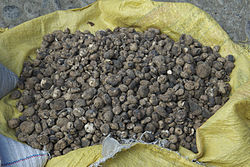Chūnō
 |
|
| Place of origin | Bolivia and Peru |
|---|---|
| Main ingredients | Potatoes |
| |
|
Chuño (Spanish pronunciation: [ˈtʃuɲo]) is a freeze-dried potato product traditionally made by Quechua and Aymara communities of Bolivia and Peru, and is known in various countries of South America, including Argentina, Bolivia, Chile and Peru. It is a five-day process, obtained by exposing a frost-resistant variety of potatoes to the very low night temperatures of the Andean Altiplano, freezing them, and subsequently exposing them to the intense sunlight of the day (this being the traditional process). The word comes from Quechua ch'uñu, meaning 'frozen potato' ('wrinkled' in the dialects of the Junín Region).
The existence of chuño dates back to before the time of the Inca Empire in the 13th century, based on findings that have been made of the product at various archeological sites. Specifically, they have been found at Tiwanaku, site of a culture which developed in the Collao Plateau, a geographic zone which includes territories of Bolivia and Peru.
It had been described in 1590 by Spanish chronicler José de Acosta.
After harvest, potatoes are selected for the production of chuño, typically small ones for ease of processing. These small potatoes are spread closely on flat ground, and allowed to freeze with low night temperatures, for about three nights.
Between the freezing nights, they are exposed to the sun, and they are trampled by foot. This eliminates what little water is still retained by the potatoes, and removes the skins, enabling subsequent freezing.
...
Wikipedia
